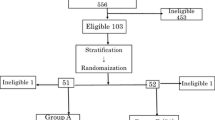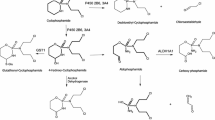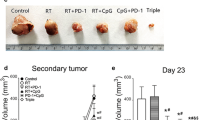Summary
A combination treatment with thymosin α1 (200 µg/kg) for 4 days, followed by a single injection of murine interferon α/β (3 × 104 international units/mouse), starting 2 days after cyclophosphamide treatment (200 mg/kg, single injection) demonstrated a dramatic and rapid disappearance of tumor burden in mice bearing Lewis lung carcinoma (3LL) tumor. The effectiveness of this new chemoimmunotherapy protocol was evident even on the long-term survival in a high percentage of animals, and was statistically significant when compared to treatment with the single agents in conjunction with chemotherapy or to chemotherapy itself. The same combination immunotherapy treatment strongly stimulated natural killer activity and cytotoxicity against autologus 3LL tumor cells in 3LL-tumor-bearing mice treated with cyclophosphamide, whereas treatments with each agent singly did not alter or only slightly modified the cytotoxic activity towards Yac-1 or 3LL target cells. Selective depletion with antibodies showed that killer cells stimulated by combination chemoimmunotherapy treatment bear phenotypic characteristics of asialo-GM1-positive cells. A histological study has shown a high number of infiltrating lymphoid cells in the tumors obtained from mice treated with combination chemoimmunotherapy.
Similar content being viewed by others
References
Bilik R, Mor C, Hazaz B, Moroz C (1989) Characterization of T-lymphocyte subpopulations infiltrating primary breast cancer. Cancer Immunol Immunother 28: 143
Bistoni F, Baccarini M, Blasi E, Pucetti P, Marconi P, Garaci E (1983) Correlation between in vivo and in vitro studies of the modulation of resistance to experimentalCandida albicans infection by cyclophosphamide in mice. Infect Immun 40: 46
Cheever MA, Greenberg PD (1985) Adoptive cellular immunotherapy. In: Immunity to cancer. Academic Press, Orlando, p 453
Cohen MH, Chretien PB, Ihde DC, Fossieck BE, Makuch R, Bunn PA, Johnston AV, Shackney SE, Matthews MJ, Lipson SD, Kenady DE, Minna JD (1979) Thymosin fraction 5 and intensive combination chemotherapy prolonging the survival of patients with small-cell lung cancer. J Am Med Assoc 241: 1813
Favalli C, Jezzi T, Mastino A, Rinaldi-Garaci C, Riccardi C, Garaci E (1985) Modulation of natural killer activity by thymosin alpha 1 and interferon. Cancer Immunol Immunother 20: 189
Favalli C, Mastino M, Jezzi T, Grelli S, Goldstein AL (1989) Synergistic effect of thymosin alpha 1 and alpha-beta interferon on NK activity in tumor-bearing mice. Int J Immunopharmacol 5: 443
Forni G, Giovarelli M, Santoni A, Modesti A, Forni M (1986) Tumor inhibition by interleukin-2 at the tumor/host interface. Biochim Biophys Acta 865: 307
Frasca D, Adorini L, Mancini C, Doria G (1986) Reconstitution of T-cell functions in aging mice by thymosin alpha 1. Immunopharmacology 11: 155
Garaci E, Mastino A, Favalli C (1989) Enhanced immune response and antitumor immunity with combinations of biological response modifiers. Bull NY Acad Med 65: 111
Goldstein AL, Low TLK, Adoo M, McClure J, Thurman GB, Rossio G, Lay CY, Chang D, Wang SS, Harwey C, Ramel AH, Meienhofer J (1977) Thymosin alpha 1: isolation and sequence analysis of an immunologically active thymic polypeptide. Proc Natl Acad Sci USA 74: 725
Goldstein AL, Schulof RS (1985) Thymosins in the treatment of cancer. In: Immunity to cancer. Academic Press, Orlando, p 469
Griffith KD, Read J, Carrasquillo JA, Carter CS, Yang JC, Fisher B, Aebersold P, Packard BS, Yu MY, Rosemberg SA (1989) In vivo distribution of adoptively transferred indium-111-labeled tumor infiltrating lymphocytes and peripheral blood lymphocytes in patients with metastatic melanoma. J Natl Cancer Inst 81: 1709
Hanna N (1986) In vivo activities of NK cells against primary and metastatic tumors in experimental animals. In: Immunobiology of natural killer cells. CRC Press, Boca Raton, Flq., p 1
Herberman RB (1985) Natural killer (NK) cells: characteristics and possible role in resistance against tumor growth. In: Immunity to cancer. Academic Press, Orlando, p 217
Herberman RB, Nunn ME, Lavrin DH (1975) Natural cytotoxic reactivity of mouse lymphoid cells against syngeneic and allogeneic tumors. I. Distribution of reactivity. Int J Cancer 16: 216
Hosokawa M, Sawamura Y, Morikage T, Okada F, Xu Z, Morikawa K, Itoh K, Kobayashi H (1988) Improved therapeutic effects of interleukin 2 after the accumulation of lymphokine-activated killer cells in tumor tissue of mice previously treated with cyclophosphamide. Cancer Immunol Immunother 26: 250
Klein AS, Lang R, Eshel I, Sharabi Y, Shoham J (1987) Modulation of immune response and tumor development in tumor-bearing mice treated by the thymic factor thymostimulin. Cancer Res 47: 3351
Lala PK, Santer V, Libenson H, Parhar RS (1985) Changes in the host natural killer cell population in mice during tumor development. I. Kinetics and in vivo significance. Cell Immunol 93: 250
Mihich E (1985) Relationships between chemotherapy and immunotherapy: a brief overview. In: Rationale of biological response modifiers in cancer treatment. Excerpta Medica, Tokyo, p 105
North RJ (1982) Cyclophosphamide-facilitated adoptive immunotherapy of established tumor depends on elimination of tumor induced suppressor cells. J Exp Med 155: 1063
Papa MZ, Yang JC, Vetto JT, Shiloni E, Eisenthal A, Rosemberg SA (1988) Combined effects of chemotherapy and interleukin 2 in the therapy of mice with advanced pulmonary tumors. Cancer Res 48: 122
Punturieri A, Santoni A, Ming WJ, Nobili N, Mantovani A, Bottazzi B (1989) In vitro migration of rat large granular lymphocytes. Cell Immunol 123: 257
Serrate SA, Schulof RS, Leondaridis L, Goldstein AL, Sztein MB (1987) Modulation of human natural killer cell cytotoxic activity, lymphokine production, and interleukin 2 receptor expression by thymic hormones. J Immunol 139: 2338
Sztein MB, Serrate SA, Goldstein AL (1986) Modulation of interleukin 2 receptor expression on normal human lymphocytes by thymic hormones. Proc Natl Acad Sci USA 83: 6107
Trinchieri G, Perussia B (1984) Biology of disease. Human natural killer cells: biologic and pathologic aspects. Lab Invest 50: 489
Uchida A (1986) The cytolytic and regulatory role of natural killer cells in human neoplasia. Biochim Biophys Acta 865: 329
Umeda Y, Sakamoto A, Nakamura J, Ishitsuka H, Yagui Y (1983) thymosin alpha 1 restores NK-cell activity and prevents tumor progression in mice immunosuppressed by cytostatics or X-rays. Cancer Immunol Immunother 15: 78
Wise JA, Mokyr MB, Dray S (1988) Effect of low-dose cyclophosphamide therapy on specific and nonspecific T cell-dependent immune response of spleen cells from mice bearing large MOPC-315 plasmacytomas. Cancer Immunol Immunother 27: 191
Zatz MM, Oliver J, Samuels C, Skotnicki AB, Sztein MB, Goldstein AL (1985) Thymosin increases production of T cell growth factor by normal human peripheral blood lymphocytes. Proc Natl Acad Sci USA 81: 2882
Author information
Authors and Affiliations
Rights and permissions
About this article
Cite this article
Garaci, E., Mastino, A., Pica, F. et al. Combination treatment using thymosin α1 and interferon after cyclophosphamide is able to cure Lewis lung carcinoma in mice. Cancer Immunol Immunother 32, 154–160 (1990). https://doi.org/10.1007/BF01771450
Received:
Accepted:
Issue Date:
DOI: https://doi.org/10.1007/BF01771450




